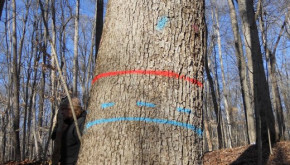
This article was written for owners of woodlands managed for timber production. There are several good reasons to harvest trees:
(1) The tree is “economically mature”…Merchantable trees are like money in the bank- the value of the annual growth of wood is like interest in a savings account. If the tree’s growth is not earning more than an acceptable rate of interest, it is time to cash it in. It usually has nothing to do with the age of the tree!
(2) The tree has become defective…Damage resulting from wind, lightning strikes or other trees falling into a tree will severely limit growth. Rot, cavities, and fungus growing on the tree are also signs of declining health.
(3) The tree has been overtopped by other trees and will struggle to produce enough food to sustain itself.
(4) The tree is competing with a more vigorous, more desirable, or more valuable tree.
(5) The crown can no longer support the tree.
(6) The tree has excessive lean.
(7) The tree has root system problems, especially undercutting.
(8) The tree has low quality wood (low limbs, knots, and curved stem) with little potential to increase in value.
(9) The tree shows signs of stress (epicormic branches, abnormal or blocky bark).
(10) Need to remove the tree so others can be planted.
(11) Market/cash value justifies sale of tree.
If you are managing your woodlands for objectives besides timber, these reasons may not apply. For example, if wildlife habitat is your primary objective, you might choose to keep rotting trees as nesting cavities for birds and mammals.
If you aren’t sure if the time is right for a harvest, consult your local state or private forester for advice.
Photo credit: David Stephens, Bugwood.org.
